|
SAN ANTONIO - Members of our
nation's military often earn military decorations or awards for their
accomplishments, and among one of the highest decorations they can
receive is the Silver Star.
It's given for gallantry in action against an enemy of the United States.
With a loud applause, and a room full of peers, friends, and family,
two Airmen received that honor Monday at a special ceremony at Joint
Base San Antonio-Lackland.
"It's an honor (and) it's surreal," said Staff Sgt. Dale C. Young, a
Silver Star-awardee. "You look at guys who have been through this
before. I've always seen those before me up on stage receiving medals,
and you definitely look up to them."
Young and Tech Sgt. Ismael Villegas both received the special decoration for their efforts in combat.
For Villegas, receiving this medal is a familiar feeling, as he was previously awarded one a few years back.
"It's never the same feeling, but it's always a surreal feeling," he
said. "I'm honored to represent my Combat Control career field."
Both men say the medals serve as a reminder of the bigger task at hand.
"You react, you shoot, you move, you communicate with everybody else.
You pray when you get a chance," Young said. "Aside from that, you're
just doing what you've been trained to do."
"We're fighting for something bigger than ourselves, and we also do it
so people can enjoy the freedoms back here," Villegas said.
Airman awarded a second Silver Star...,....
Tech. Sgt. Ismael Villegas was awarded the Silver Star in a San Antonio
ceremony Monday, marking only the second time in a dozen years that a
member of the Air Force Special Operations Command has been given the
honor twice.
Standing before Lt. Gen. Eric Fiel, Villegas, 35,
of Del Rio was given the Silver Star along with another airman, Staff
Sgt. Dale Young.
Both were described by a fellow war veteran as quiet, humble and even laid back, with Villegas likened to a California surfer.
“I
had no idea he had a Silver Star until today,” said Air Force Tech.
Sgt. Israel Del Toro, who called in airstrikes in Afghanistan until
badly injured in a 2005 bomb blast. “Then I found out he had two.”
Villegas
and Young, 29, were given the awards at Joint Base San
Antonio-Lackland. Both are Combat Controllers who led airstrikes
against entrenched insurgents in Afghanistan. |
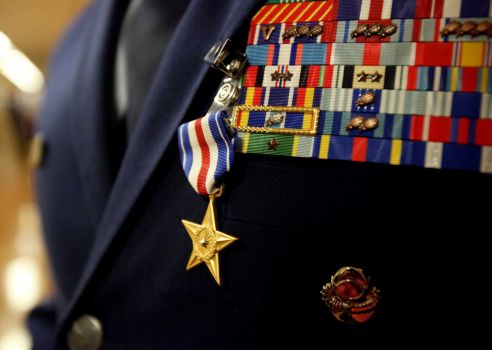 |
Villegas received his first Silver Star in October 2011 from then-Air Force Chief of Staff Gen. Norton Schwartz.
A Combat Controller is not only qualified to call airstrikes for Air
Force Special Operations, but also is an Federal Aviation
Administration-certified air traffic controller. The job involves
mastering many tasks, from making parachute jumps into enemy territory
and scuba diving to riding motorcycles and marching through any weather
— often fighting in remote and desolate locations.
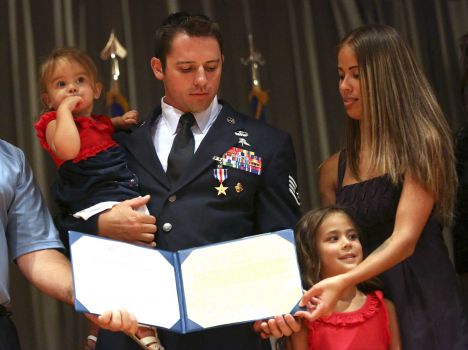 |
“The normal person in the Air Force does not live their life outside
the wire. These guys live outside the wire,” said Fiel, who noted that
most aircraft crews and maintenance specialists live and work on air
bases. “But the special tactics community lives outside the wire, and
they've been doing so for 12 years.”
A native of Akron, Ohio,
Young and an Army Special Forces team he was with came under intense
fire for 94 hours while conducting an operation in 2009. He guided
bombs from 11 coalition aircraft while taking small-arms and rocket
fire that missed him by just 10 yards.
A citation for his
Silver Star said Young's “calm demeanor under fire, leadership in the
face of grave danger and ability to simultaneously conduct precision
attacks ..., undoubtedly saved the lives of numerous personnel.” It
also credited his actions with ensuring that a black tar opium cache
valued at $1 billion was destroyed.
He has served twice in Afghanistan.
“Ninety-four
hours,” said Fiel, who led a special operations squadron in Bosnia and
Kosovo and later served in Iraq and Afghanistan. “That's like you got
up Friday morning and it's all the way through today (Monday), and
Villegas having his second one, that's amazing.” |
Only 30 airmen in the Air Force Special Operations Command have been
given Silver Stars, with Staff Sgt. Sean Harvell holding two. Five
airmen in the command hold the Air Force Cross, the service's
second-highest award below the Medal of Honor.
Villegas survived a number of engagements over a three-week period in
2011. In one battle, a Special Forces soldier was hit by fragments from
a rocket-propelled grenade, and Villegas laid down covering fire and
rushed to help the downed GI despite taking heavy fire.
A Silver Star citation credited Villegas, a native of Mexico City, with
controlling 40 aircraft that dropped 32,500 pounds of bombs over his
18-day mission. It also said he constantly risked his life during a
series of engagements.
That included the battle in which he pulled the wounded man behind a
wall, placed himself between insurgents and his team, and then provided
cover fire so those in his patrol could “fight their way out of
the kill zone,” the citation stated.
“I didn't really have a lot of time to think,” Villegas,
who has deployed seven times to Afghanistan and once to Iraq, said when
asked to describe the moment he inserted himself between his team and
the enemy. “I just heard him yell, and I just reacted.”
|
Two Combat Controllers with a decade of connected service will share the stage to receive medals of valor.
For one, he will become just the
second airman to receive two of the highest three valor awards in the
global war on terror. The other will stand next to his former mentor
and be honored for a battle that helped turn the tide in Afghanistan.
Tech. Sgt. Ismael Villegas will
receive a Silver Star with the first oak leaf cluster July 22 for
actions during an 18-day battle in February 2011 in Afghanistan,
helping destroy more than 20 insurgents and their holdouts, along with
saving a Green Beret.
Staff Sgt. Dale Young will
receive his first Silver Star for a four-day battle in May 2009 that
resulted in the deaths of more than 90 insurgents and destruction of
more than $1 billion in black-tar heroin.
The two Combat Controllers have
known each other for more than a decade, with Villegas taking Young
under his wing during his first assignment at RAF Lakenheath, England.
“Tech. Sgt. Villegas and
Staff Sgt. Young are perfect examples of what it means to be a
battlefield airman,” said Lt. Gen. Eric Fiel, commander of Air
Force Special Operations Command. They risked their lives and
courageously engaged with enemy forces for days and weeks at a time to
ensure the successful completion of their missions and the safety of
their SOF teammates. It is inspiring and humbling to serve with these
warriors, and I am honored to present them with the Silver Star.”
| 'Stirring up a hornet's nest' |
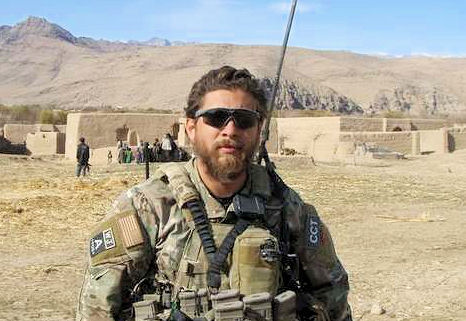 |
On Feb. 6, 2011, Villeagas was serving
as the lead joint terminal attack controller with a group of elite Army
Green Berets. He and his team were tasked with retaking an area of
Helmand Province.
It was supposed to be a weeklong mission.
Immediately
upon entering the area, the group met stiff resistance from enemy small
arms fire, improvised explosive devices and mortars. The group pushed
through, holding their objective and forming an area hold so the
Taliban wouldn’t come back in behind and surround the group.
Their task: to hold the area, and it wasn’t easy.
“It
was pretty much trench warfare,” Villegas said. “There were a lot of
RPGs, a lot of mortars. We continued to fight through the assault
though.
“The
area hadn’t had any U.S. or coalition presence in a few years, so we
encountered a lot of resistance. We had to establish a presence, and we
ended up stirring a hornets nest, so to speak.” |
The
resistance was so fierce, the team’s mission was extended by more
than a week. The Silver Star citation outlines three instances of valor
where Villegas “selflessly and repeatedly risked his life during
nonstop enemy engagements.”
“We were extremely
effective, and there was a lot more enemy than we initially
anticipated,” Villegas said. “It was necessary to clear the
area.”
During a battle early in the
mission, a friendly element was pinned down by hostile fire. Villegas
ran toward the troops to get a sight on the insurgent’s position.
While completely exposed to the small arms fire, Villegas coordinated
with an overhead remotely piloted aircraft and fixed-wing air support
to drop 14,000 pounds of bombs.
In another instance, Villegas
volunteered for a patrol to explore the area, and his team came under
enemy fire. The group was inside a structure, stacked up on a door,
when an RPG hit. Shrapnel shredded the wall in front of them and hit a
Green Beret soldier next to him.
“I heard the screams, so I grabbed him, pulled him back and began directing air support in the area,” he said.
Villegas moved between his team
and the enemy, providing additional cover fire and controlled close air
support within 60 meters of him to stop the onslaught and help the
patrol fight their way over the kill zone.
Over the course of the 18-day
mission, Villegas controlled 40 aircraft, dropping more than 32,500
pounds of ordnance. His work resulted in 21 enemy killed and the
destruction of eight fighting positions and two communication repeaters.
With the awarding of the second
Silver Star, Villegas joins an exlusive club. He is only the second
airman to receive multiple high valor awards in the global war on
terror, joining Staff Sgt. Sean Harvell,
according to Doug Sterner, the curator of the Military Times Hall of
Valor. There are a total of 11 troops across all services to be awarded
multiple high valor awards.
Villegas was presented his first
Silver Star in 2011, for a September 2009 battle in Afghanistan. In
that instance, he was the only JTAC in an Army Special Forces team
tasked with clearing a road of IEDs near Bagh Kosak when his team was
ambushed. He ran 200 feet across an open minefield to a higher position
to return fire and call in air support. During the 16-hour firefight,
the airstrikes killed 32 enemy insurgents and saved the lives of his
teammates.
Villegas, a 16-year Air Force
veteran, has now been twice recognized for his work with Green Berets
— the elite troops that first drew him to the military. His plan
originally was to join the Green Berets or other special operations
forces, until he came across a pamphlet about Combat Controllers.
To him, the awards show the importance of the training Combat Controllers receive.
“It’s pretty
humbling to represent the Combat Controller community,” said
Villegas, now a recruiting liaison at Joint Base San Antonio. “A
lot of credit goes to the Combat Controllers that trained me and the
training I received.”
For now, he’s enjoying his
liaison position. But going forward, “wherever the Air Force
calls me to service is where I’ll go.”
| Operation Siege Engine |
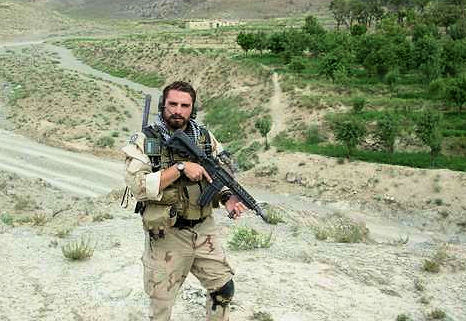 |
Staff Sgt. Dale Young took a similar
route to the Air Force, an interest in special operations that brought
him to the Combat Controller community. He was only 17 when he enlisted
in his home town of Akron, Ohio, convincing his parents to agree to let
him join.
Over
an 11-year career, he has deployed twice as a JTAC. In May 2009, he
joined a team of Army Special Forces, Navy SEALS, Air Force Combat
Controllers, Afghan commandos and other government agencies for
Operation Siege Engine, a large onslaught into Taliban-controlled
territory to get it ready for U.S. Marines to come in and hold.
It was a known enemy stronghold near Helmand Province and a known headquarters with big money from drug traffickers, Young said.
The
team moved in under the cover of darkness May 19, and at first, there
was no enemy contact. They moved in to the village. Two roads in the
village center crossed at a bazaar, and this is where the Taliban began
to fight.
It began with small arms fire from within 150 meters. Then RPGs and 107 millimeter rockets. |
“Some of the elements were receiving fire so intense that they couldn’t return fire,” Young said.
Young, the lead JTAC on the
team, ran to the center of the village and found the highest vantage
point he could. He began coordinating with an AC-130 and helicopter
gunships above. He directed a show of force, gun strages to try to
quell the enemy fire. The fighting continued, with some enemy small
arms and rocket fire impacting within 10 meters of Young’s
position, the award citation says.
He broke his cover, found a better view of the enemy location and radioed aircraft above to drop 500-pound bombs onthe enemy.
“The guns were not as effective as we would have liked,” Young said.
The firefights were on and off
at times during the 94-hour battle. At one point, another JTAC was
wounded. Young organized the aircraft above to bring in a UH-60 Pave
Hawk to medically evacuate the airman.
On the last day of the mission,
Young got intel that there was a high-value target in the area and
coordinated with a remotely piloted aircraft to launch two Hellfire
missiles. At another location, a sniper was holed up in a compound that
intelligence showed held a Taliban leader. That ended with two
2,000-pound bombs dropped from B-1B Lancers.
“After that, there really wasn’t any more enemy activity,” Young said.
After quieting the area, the
team found a massive enemy cache: $1.2 billion worth of black-tar
heroin, 300,000 pounds of poppy seeds, IED making materials and
weapons. Their mission of clearing the area was complete. With one
thing left to do, Young radioed the coordinates of the cache to the
B-1s.
“We were making sure the
enemy couldn’t come back to use it, sell it or have any effect in
that area whatsover,” Young said.
On the ex-filtration helicopter,
Young made sure all personnel were accounted for. As they flew away
from the battlefield, he gave the go-ahead for the B-1s to drop
thousands of pounds of bombs in the area and the weapons and drug
caches. Young estimates that the B-1s dropped more than 90,000 pounds
of ordnance.
All told, the enemy equipment
and drugs were destroyed, and Young’s actions during nearly four
days of battle contributed to more than 90 Taliban killed in action.
“We were to prepare the
area for the Marines; we didn’t expect this much enemy
combat,” Young said. “But as the 94 hours continued,
that’s what happened.”
Young is now an instructor at
the Combat Controller selection course at Joint Base San Antonio, and
he is finishing his degree. But after so much time in, “it would
be a waste to get out for sure,” and he is considering putting
his name in to become a special tactics officer.
For him, the Silver Star highlights the team effort. Everyone had a job, and he did his.
“There were so many people
involved on this mission,” he said. “It just goes to show
how well we worked together. It’s an absolute honor to receive
the Silver Star.
“Looking at the guys
previously awarded, these guys make history in our career field and in
the Air Force. It’s a great thing for Combat Control. ... You
never stop learning. You’ve got to take advantage of the people
who have gone before you.”
| JOINT BASE SAN ANTONIO-LACKLAND -- Two Air Force Special Operations
Command Combat Controllers stationed in San Antonio were each presented
a Silver Star for gallantry in combat. |
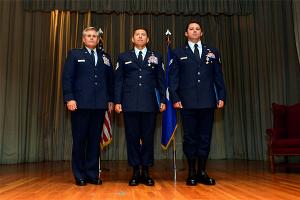 |
The
two Combat Controllers, Tech. Sgt. Ismael Villegas and Staff Sgt. Dale
Young, were decorated by Lt. Gen. Eric E. Fiel, the commander of the
Air Force Special Operations Command, Hurlburt Field, Fla.
The Silver Star is the third highest award exclusively for combat valor.
"Gentlemen, your
bravery and tenacity epitomize what being a warrior is all about," Fiel
said during the ceremony. "Your brave actions under hostile fire at
great risk to your lives not only decimated the enemy, but also saved
lives of your teammates. Your unwavering gallantry and devotion to duty
are an example for all of us to follow."
|
It was the second Silver Star awarded to Villegas, who is currently the
only active-duty two-time recipient in the Air Force. Villegas is
assigned to the 24th Special Operations Wing at Hurlburt Field and
presently works as a recruiting liaison for the 369th Air Force
Recruiting Group at Lackland.
Young is assigned to the 342nd
Training Squadron at Lackland as an instructor in the entry level
course for all special operators.
Both recipients expressed how humbled and honored they were by the award.
"I was surprised," Young said.
"It was submitted as a Bronze Star with Valor and after statements from
some of my team members, different boards recommended an upgrade to
Silver Star. It's an honor."
Villegas, a 16-year veteran with eight deployments, used "surreal and shock" to describe his reaction.
"The first one (in 2011)
you don't even expect -- that in itself is a shock," he said. "To
receive two -- that's even more incredible. For me to be awarded a
second one is even more of a shock."
Both men received their
awards for gallantry in action during separate military operations near
Helmand province, Afghanistan.
Villegas' citation states
he risked his life from Feb. 6 - 24, 2011 during nonstop enemy
engagements. In an 18-day mission riddled with trench warfare battles,
Villegas controlled 40 aircraft that delivered more than 32,500 pounds
of precision ordnance. The air strikes resulted in 21 enemies confirmed
killed in action and destroyed eight fighting positions and two
communication repeaters.
During the mission,
Villegas gathered intelligence from fortified insurgent positions at
great risk. He also protected, covered, then pulled to safety a
teammate hit by shrapnel.
Col. Marc Stratton, the
commandant of the Inter-American Air Forces Academy at Lackland, was
one of Villegas' first commanders when both served in the 21st Special
Tactics Squadron, Pope Air Force Base, N.C., in 2002. Stratton is a
special tactics officer who has spent 25 years in the career field.
He recalled that Villegas,
then a senior airman, impressed his teammates in the field when
directly engaged with the enemy on numerous missions during his first
deployment to Afghanistan.
"Little did any of us
know, at the time, that we would be here many years later at an event
recognizing his courage under fire, not merely for one isolated
incident, but for consecutive exceptional selfless actions during
successive engagements over time," Stratton said.
"In short, this oak leaf
cluster carries a great deal of significance," he said. "The award of a
second Silver Star is very rare for good reason."
Young compared the award upgrade to "the kind of stuff you see in movies and TV."
"You never really see
yourself in that position," he said. "The training we get is so good,
so precise and key in building our skills.
"This is a tribute to my
supervisors, the first controllers I met and the ones who taught me
everything I know," Young said.
From May 19-23, 2009, near
Helmand province, Young's citation states he served as the primary
Combat Control joint terminal attack controller assigned to an Army
Special Forces team. Young's element was under continuous enemy fire
for 94 hours.
Young controlled up to 11
coalition aircraft and ensured safe and effective fires on enemy
positions despite small-arms and rocket fire within 10 meters of his
position. The mission also destroyed more than $1 billion in black tar
opium.
During his remarks, the AFSOC commander cited the humility and training of special operations Airmen.
"Special operations is a
community of quiet professionals," Fiel said. "If you ask these men or
anyone who wears our berets their thoughts about decorations, I think
they would all say, 'I was just doing what I was trained to do.'
"The citations detail your amazing acts of heroism and bravery," he said. "Your stories are truly inspiring."
Combat Controllers Bring Doom on Al Qaeda & The Taliban
If asked to name, without a shred of evidence or data for backup, three
groups of American combatants that have caused the most mayhem and
chaos in Al-Qaeda and the Taliban, these would be my guess: Apache
helicopter pilot/gunners, AC-130 gunners, and Air Force Combat
Controllers. |
Please
read this Air Force Times article (above) about two of the latter,
Combat Controllers Technical Sergeant Ismael Villegas and Staff
Sergeant Dale Young, and the awards they earned.
With his second Silver Star, TSgt Villegas joins that rare group of
heroes with TWO of the 3 highest awards for valor in the global war on
terror. He is the second Airman to achieve this, following in the
footsteps of fellow Combat Controller Sean Harvell. Outstanding job, TSgt Villegas… FIRST THERE!- BK
From the article: TSgt Villegas:
During a battle early in the mission, a friendly element was pinned
down by hostile fire. Villegas ran toward the troops to get a sight on
the insurgent’s position. While completely exposed to the small
arms fire, Villegas coordinated with an overhead remotely piloted
aircraft and fixed-wing air support to drop 14,000 pounds of bombs.
In another instance, Villegas volunteered for a patrol to explore the
area, and his team came under enemy fire. The group was inside a
structure, stacked up on a door, when an RPG hit. Shrapnel shredded the
wall in front of them and hit a Green Beret soldier next to him. |
 |
“I heard the screams, so I grabbed him, pulled him back and began directing air support in the area,” he said.
Villegas moved between his team
and the enemy, providing additional cover fire and controlled close air
support within 60 meters of him to stop the onslaught and help the
patrol fight their way over the kill zone.
Over the course of the 18-day
mission, Villegas controlled 40 aircraft, dropping more than 32,500
pounds of ordnance. His work resulted in 21 enemy killed and the
destruction of eight fighting positions and two communication
repeaters…
From the article: SSgt Young: In
May 2009, he joined a team of Army Special Forces, Navy SEALS, Air
Force combat controllers, Afghan commandos and other government
agencies for Operation Siege Engine, a large onslaught into
Taliban-controlled territory to get it ready for U.S. Marines to come
in and hold.
It was a known enemy stronghold near Helmand Province and a known headquarters with big money from drug traffickers, Young said.
The team moved in under the
cover of darkness May 19, and at first, there was no enemy contact.
They moved in to the village. Two roads in the village center crossed
at a bazaar, and this is where the Taliban began to fight.
It began with small arms fire from within 150 meters. Then RPGs and 107 millimeter rockets.
“Some of the elements were receiving fire so intense that they couldn’t return fire,” Young said.
Young, the lead JTAC on the
team, ran to the center of the village and found the highest vantage
point he could. He began coordinating with an AC-130 and helicopter
gunships above. He directed a show of force to try to quell the enemy
fire. The fighting continued, with some enemy small arms and rocket
fire impacting within 10 meters of Young’s position, the award
citation says.
He broke his cover, found a better view of the enemy location and radioed aircraft above to drop 500-pound bombs on the enemy.
“The guns were not as effective as we would have liked,” Young said.
The firefights were on and off
at times during the 94-hour battle. At one point, another JTAC was
wounded. Young organized the aircraft above to bring in a UH-60 Pave
Hawk to medically evacuate the airman.
|